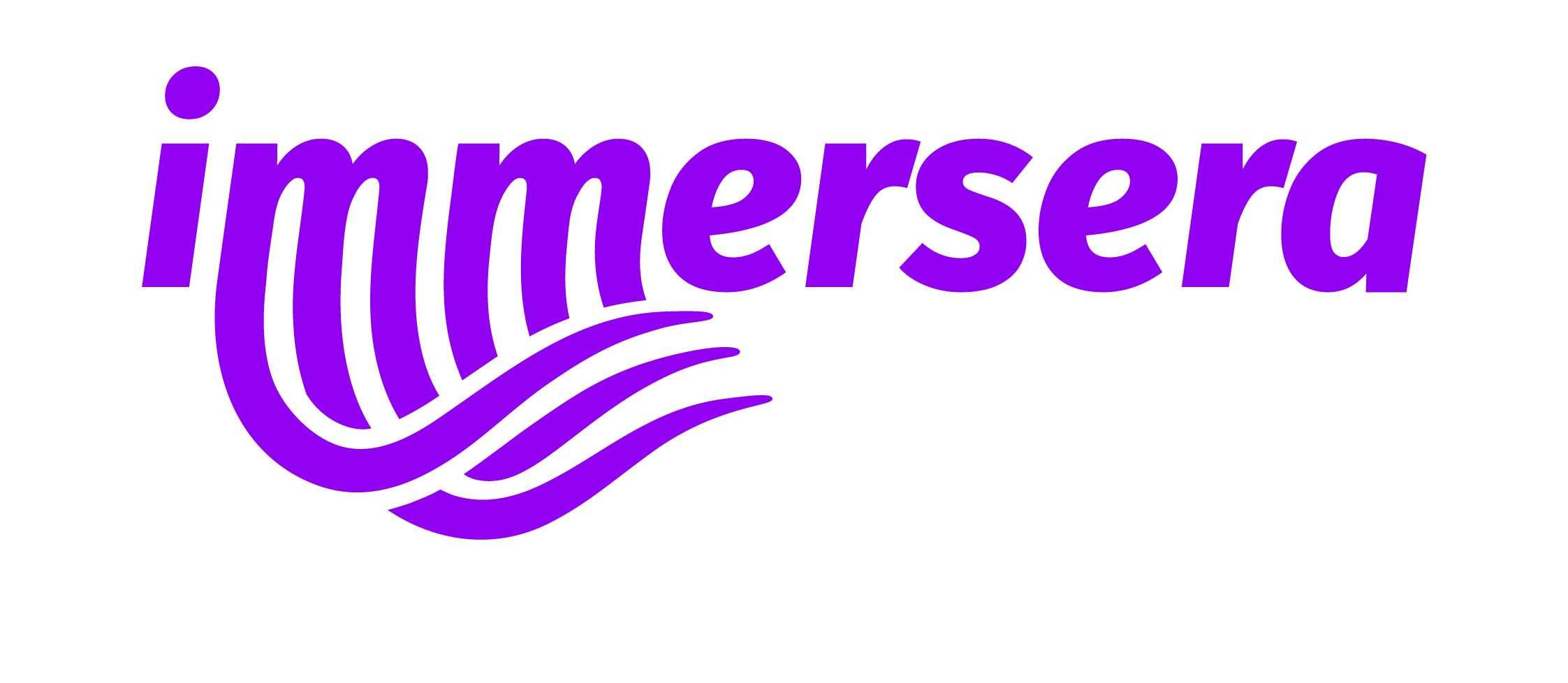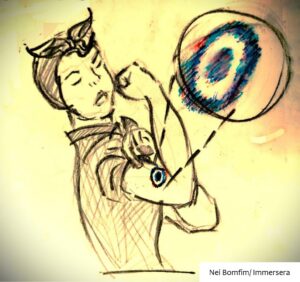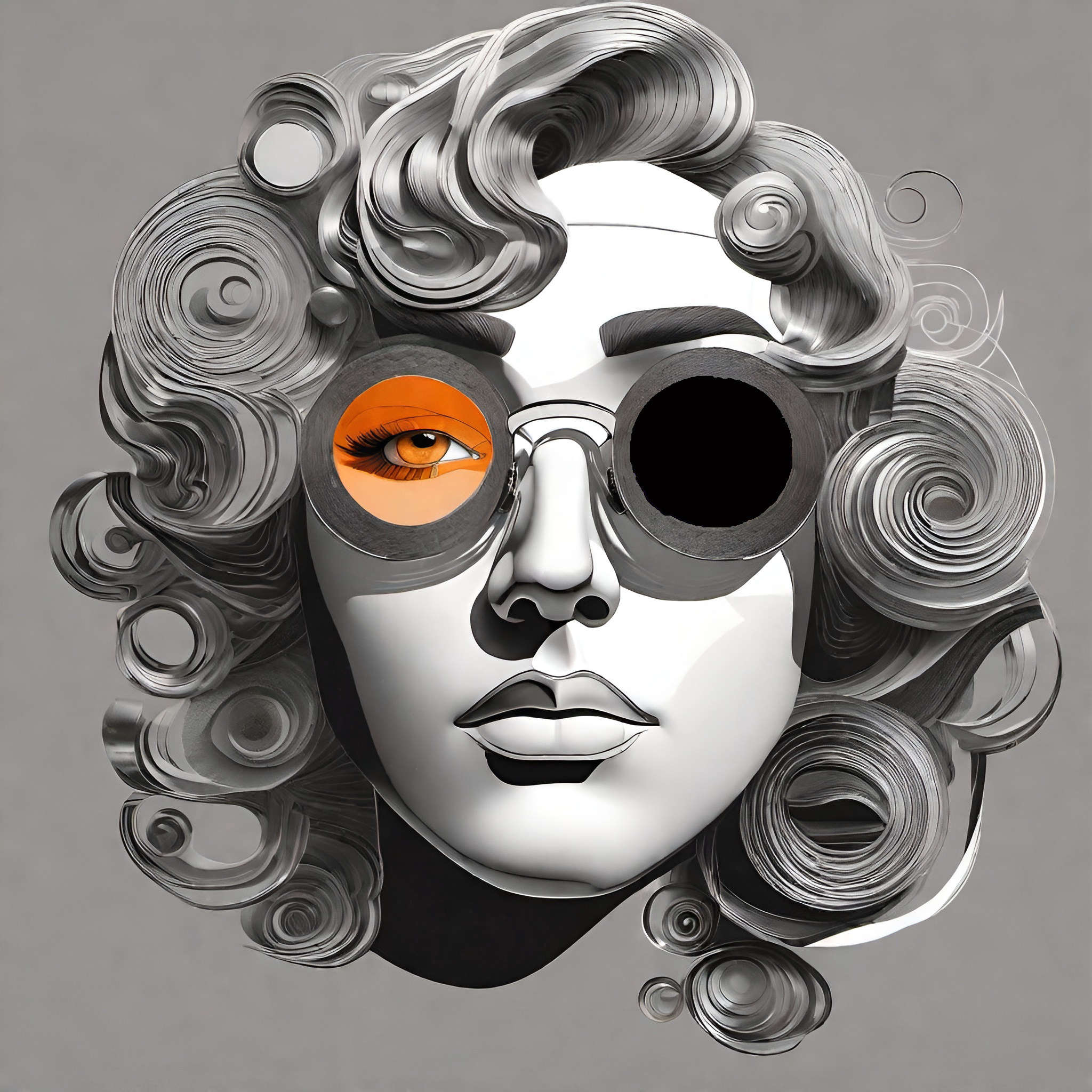
Nei Bomfim/ Immersera over
Wombo [incorrect] delivery
Wombo’s incorrect two-eyed delivery as prompted for ‘Cyclops’; for intrigue, I reshaped one of the eyes via blackout
How Weak-Class Gen AI Can Save ’n’ Power Brand 0.1-Sec-Positioning
How Weak-Class Gen AI Can Save ’n’ Power Brand 0.1-Sec-Positioning
Very well-written, focused prompts—plus some luck—can generate successful anti-0.1-Sec-Scrolling visuals; but only 1 out of 9 apps I tested knew Cyclopes, Immersera’s visual theme, despite X-Men
Brand positioning—conquering a place in the hearts and minds, according to masters Kottler, Ries, and Trout—is transforming itself from the analog process, where humans translate concepts into visuals, texts, etc., to a much more dynamic, merciless approach.
Perceiving this shift is crucial because brands online have a mere 0.1 seconds to make a first impression (Missouri Univ), more than ever in this AImmersive era, as I call it. A brand’s ability to get this 0.1-Sec-Positioning will determine whether it hooks and rocks or turns… 0.1-sec-scrolled. That’s where visuals come in—and are now the absolute standard.
The good news here is that we can create these 0.1-Sec-Positioning visuals by injecting Gen AI’s prompts with “germ cells,” as we could call a more laborious, sometimes more creative, type of prompt-modifiers. How this happens is what we’ll see in this article.
I tested this creation of these 0.1-Sec-Positioning visuals on nine apps, both free and paid, from DALL-E to Midjourney to Stable Diffusion. I used my network, Immersera, as the test subject, since our positioning is… 0.1-Sec-Positioning brands. This required Gen AI to go beyond positioning: meta positioning, haha — proving the power of visuals through… visuals.
The difficulty of that mission was made harder because, remember, Gen AI is currently “weak class,” a LLM (Large Language Model) rather than “intelligence.”
The Circus Challenge
- Neutralize that lethal 0.1-Sec-Scrolling inertia over our brand’s content—via some attraction—in that same 0.1 sec…
- …through what? By consistently displaying your 0.1-Sec-Positioning—which implies…
- …this attraction should not appear vaguely as mere bait but rather be precisely positioned on the desired audience(s).
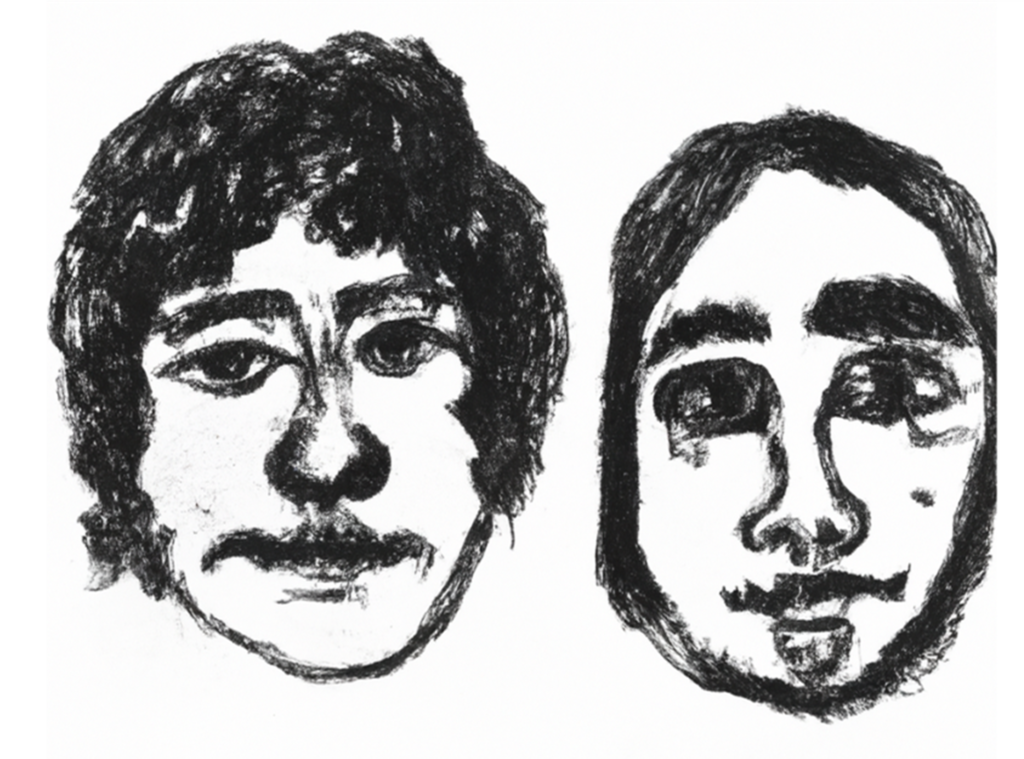
DALL-E bordered on comical under Canva by giving these 2-eyed after being the only one to get right Cyclops with Bing
Vision: 70% of All Human Sensors
It’s all about visuals for evolutionary reasons:
> Our eyes concentrate around 70% of all the body’s sensors;
> 40% of the cortex is involved in processing/understanding visual information;
> 80% of all information comes to us through the eyes;
> We react first to visuals and retain them; 93% of communication is non-verbal;
> Images go straight to long-term memory; words go to short-term one, which retains only about 7 bits.
Besides that, the visuals’ role—and, in a bowling strike, the digital positioning, Comms, etc.—has been strongly re-designed by
1) A planetary immersion into screen caused by the pandemic—immersion that obviously happened mainly via visuals;
2) The current massive Gen AImmersion, as I call it, with its crazy paradox of visuals’ simultaneous revolution and standardization. We see the result of this paradox in those flooding over-colored Gen-AI pics of astronaut squirrels, for example. They, as standardization, are evidently cheap shopping mall surrealism. Considering the crucial need for brands to differentiate themselves and the possibilities of Gen AI to accomplish this, that diagnosis of standardization is a true blinking red “paradox.”
Visuals: Brand’s Login into Its Audiences
This cheap shopping mall surrealism makes the situation worse because there was already a flood of repeated images from image banks that we could call TaNoCo images (Table+Notebook+Coffee)—despite the fabulous richness of these banks, which are often free. Articles denounce this flood.
The sin of laziness has converted those resources to a poor “mechanical” function, no longer the emotional ones typically expected from an image. (We’ll talk a lot about visuals in this blog).
On the contrary, all the above data demonstrate that we must relocate visuals/images even from their current analogical function of “illustration.” The 0.1-Sec-Positioning-or-Scrolling fundamental converted visuals into the actual brand’s login into its audiences.
No wonder AI firms make vision the first choice over all the other human senses.
Based on that, the current AImmersive era is converting the positioning mission into a, let’s say, zeta-informed process. This change by itself doesn’t grant touching visual content, as we’ll see below. Hence, the importance of human curation. But we may get good surprises (below).
Visuals’ Primordiality = One-Eyed Giants
Let’s move on to that real and practical test.
- Immersera needs to position itself as a network expert on 0.1-Sec-Positioning (through some services*). Based on the above data, what could be the agent of Immersera’s meta positioning other than visuals?
- I then deepened the realization that I needed visuals—from the Visual Identity to the images of the posts, etc.—able of injecting in 0.1 sec the sensation of visuals as the kings of positioning injection (always that damn meta positioning, haha);
- I found an icon to immediately materialize this demand: the fantastic one-eyed giants, the Cyclopes (remember? They come from the mythical Greek celestial blacksmiths till the X-Men). “Cyclopes” translates as “circular eye,” which means iterative and circular focus—therefore, the visual that sells the visual. Can you be indifferent to the unique gaze of the Cyclopes?
- So, I asked nine Gen AI apps to make a classic pencil drawing of two contemporary Cyclopes faces representing the polarization between positioning and scrolling. This choice of an almost Franciscan pencil aims to distinguish Immersera from that flood of standardized overcoloring, etc. So, to help differentiate the result and generate an even sharper positioning, I prompted the Cyclopes: one as an ordinary boy from the Brazilian outskirts and the other as a 35-year-old man/woman with curly hair;
- That duo, which I called Takuara & Robson, “obviously must be one-eyed,” I emphasized to all nine tested apps.
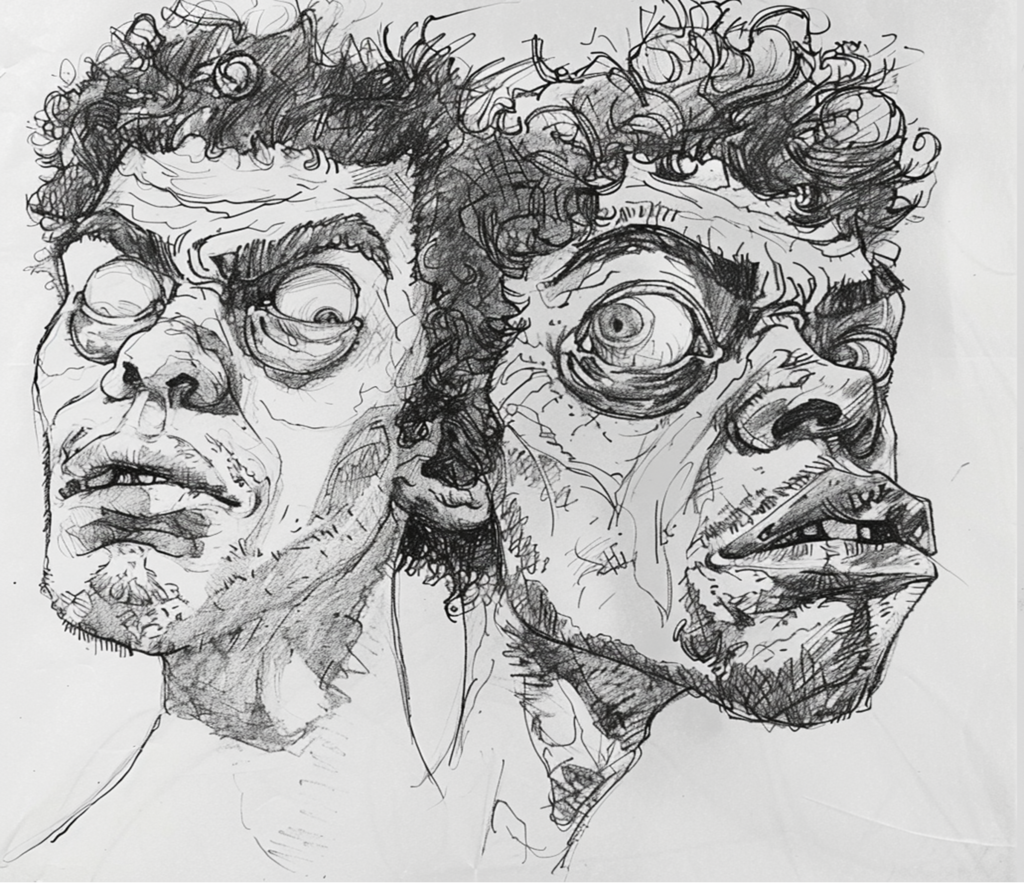
Midjourney’s ‘Cyclops’: flawed like minor apps, the usual two-eyed guys
8 – 1
The nine apps I tested spanned from two of them associated with DALL-E (Bing/ CoPilot and Canva) to Midjourney, Stable Diffusion, AI ART Generator, DaVinci AI Photo Gen, Imagine AI Art Generator, Wombo, and Wonder AI Art Generator.
ONLY ONE of those apps, Bing CoPilot/ DALL-E, knew what those bloody Cyclopes were—despite these creatures being a nowadays profitable movie and game character. Meanwhile, another platform powered by DALL-E, Canva, failed: delivered trivial two-eyed guys. Same frustration from Stable Diffusion and Midjourney—this confusedly bet on a third eye.
Things worsened with the Wombo app. Wombo destroyed Robson’s legitimate single eye to give him two eye sockets. Well, all of us know the weaknesses of Gen AI: its libraries, training parameters, pairings, and, consequently, deliveries.
That doesn’t mean it was easy to negotiate with Bing CoPilot/DALL-E: I had to write several replies of up to 2k characters (this blog will write a lot about prompts). Finally, it delivered Cyclops Takuara, the boy who blinks so much because of scrolling, and Robson, the guy who blinks slower thanks to positioning.
Bing/DALL-E also responded to one of my replies for visual positioning in a classic pencil style in a crazy way. It simply inserted a giant pencil in the image (!!): in other words, it converted what was a style request into a character (!!). About Takuara and Robson, you can see the official version of the duo on the home page of this blog.
Injectable Positioning
After all, why and “how weak-class Gen AI can save ’n’ power brand 0.1-sec-positioning”?
Because of its astronomical productivity—if it is injected creatively and precisely with positioning. This precise injection is essential, since intricate pairings and interactions within these zeta-sized libraries can generate unexpected results—good (less frequently, as we know) as well as hallucinated ones.
According to the rules of each app, the positioning statement must be carefully mixed with other concentric elements (i.e., almost redundancies in the search for precision) or eccentric ones (additions), always with descriptive excellence—of course, with the length allowed by each app determining this excellence;
> besides clarity; careful maneuvering of conjunctions, precious glue for detailed and intricate verbal constructions, in a fight with synthesis. This care is crucial regarding adversative conjunctions, since Gen AIs can understand negations as an affirmative parameter.
> Keeping Immersera as an example, I requested a “classic pencil drawing of Cyclops,” adding “germ cells” ranging from the ridiculously redundant “one-eye socket with only one eye located just above the nose” to “hedonistic face” (this one was only on Canva), etc. “Pencil style” plus “as few lines as possible” is an attempt to avoid those undifferentiated, cheesy results of cheap mall surrealism.
This process included several different prompts and many, sometimes lengthy, replicas. But as you know, for now you will lose in many cases.
One of the only right Cyclops (one-eyed), by CoPilot/ DALLE: faithful to prompt, plus surprising features
Surprisingly Random Overfed Nodes
Until you win—which is what happens when you get what we might call “surprisingly random overfed nodes.” I’m referring to unique and highly random convergences of text-image pairs with fine-tuned parameters. I illustrate this with Takuara and Robson.
The version of the duo I chose represents 1) Almost all the “germ cells” I injected into the prompt and 2) Features beyond those requested.
By these “features beyond those requested,” I mean the unexpected inspirations that Takuara and Robson’s unique appearance provokes, at least on me. Takuara looks like an unexpected fusion between an ancient African icon and a boy from the Brazilian suburbs. In the 0.1-Sec-Positioning-or-Scrolling polarization, his frenetic blinking represents 0.1-Sec-Scrolling.
Robson, on the other hand, inspires a slight hedonism, which can be inferred from his broad, almost transcendental face and “slow-motion” impression (when compared, of course, to Takuara). Its slightly less manic blinking emits the 0.1-Sec-Positioning, I find—typical of someone who stops scrolling in a more leisurely reading because they are attracted to a post.
But the germ cells I injected into this prompt did not prescribe “similar to an ancient African icon” (Takuara) or “light and quirky hedonism, etc.” (Robson). Only after, as mentioned, I tried in vain to “hedonism” in Canva did I realize these features beyond prompt were, therefore, happy accidents. They have orchestrated an essential dimension of perception—always visual.
How did these happy accidents appear? They arise from extensive libraries, from datasets from text-image pairs and many parameters (those 12 billion in the case of DALL-E 2, while its source ChatGPT-3 has 175 billion); from a significant degree of randomness that arises from the appropriation of those Gen AI platforms by each app. So much so that the same DALL-E that impressed via Bing with improved Takuara and Robson, disappointed with unrecognizable two-eyed Cyclops (??) in Canva.
In this sense, it is interesting to try out adjustments that the apps offer in addition to the ready-to-use style grid. In the case of DALL-E/Bing, the Temperature parameter—from Exact to Creative and Balanced.
So?
- Doing your best to craft excellent prompt texts (including emojis, etc.): prioritize clarity (to the point of occasional ridiculous redundancy) by incorporating inspiring “germ cells”, a kind of “prompt-modifiers,” and bet on replicas;
- Do not forget that the current Gen AI is a weak class—so adjust parameters and invest considerable effort and patience;
- Accept risks in unknown territories—innovative stimuli such as “punk marketing,” for example, and others can help for pragmatic reasons.
At Immersera, based on my verbal-visual synergy (used to be Comms Head for three Gov Ministers and C.H. consultant for UN-Women), on my certs like on AI (USP and Exame), and on our network’s expertise, we provide consultancy/mentoring on 0.1-Sec-Positioning, positioned content, SEO, branding, websites, cases, and crisis management.
